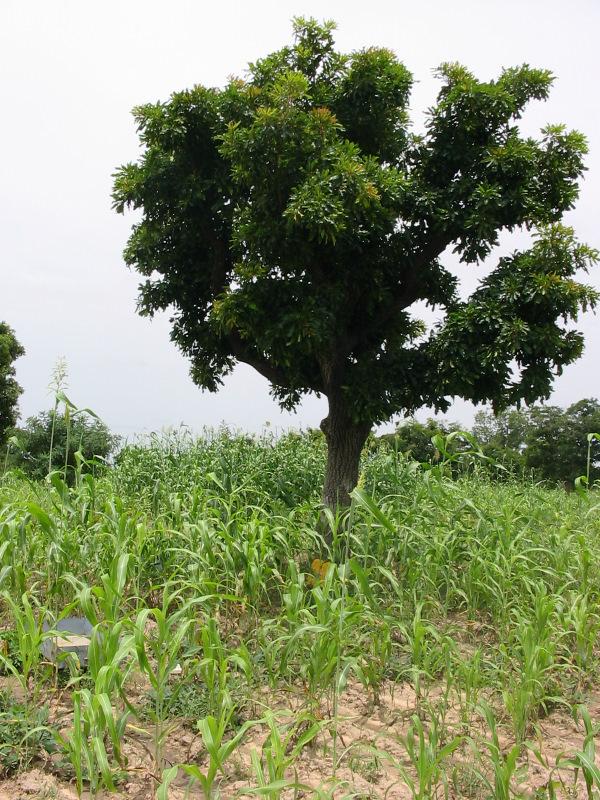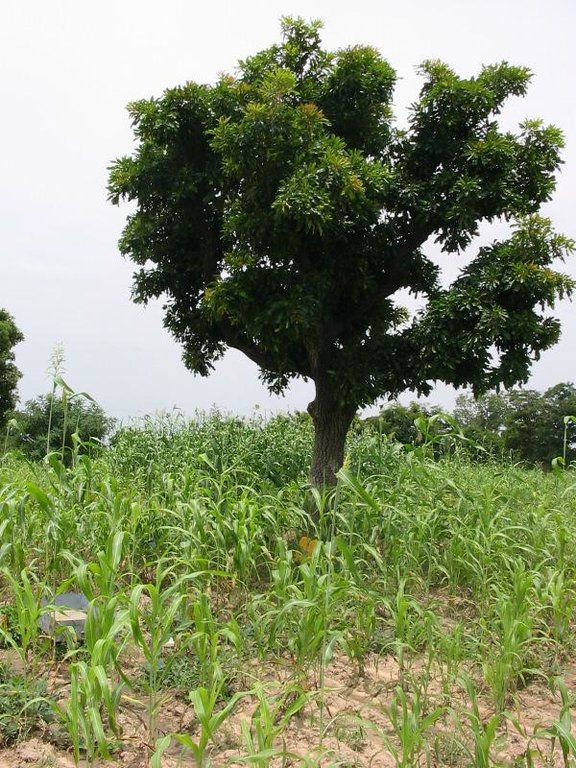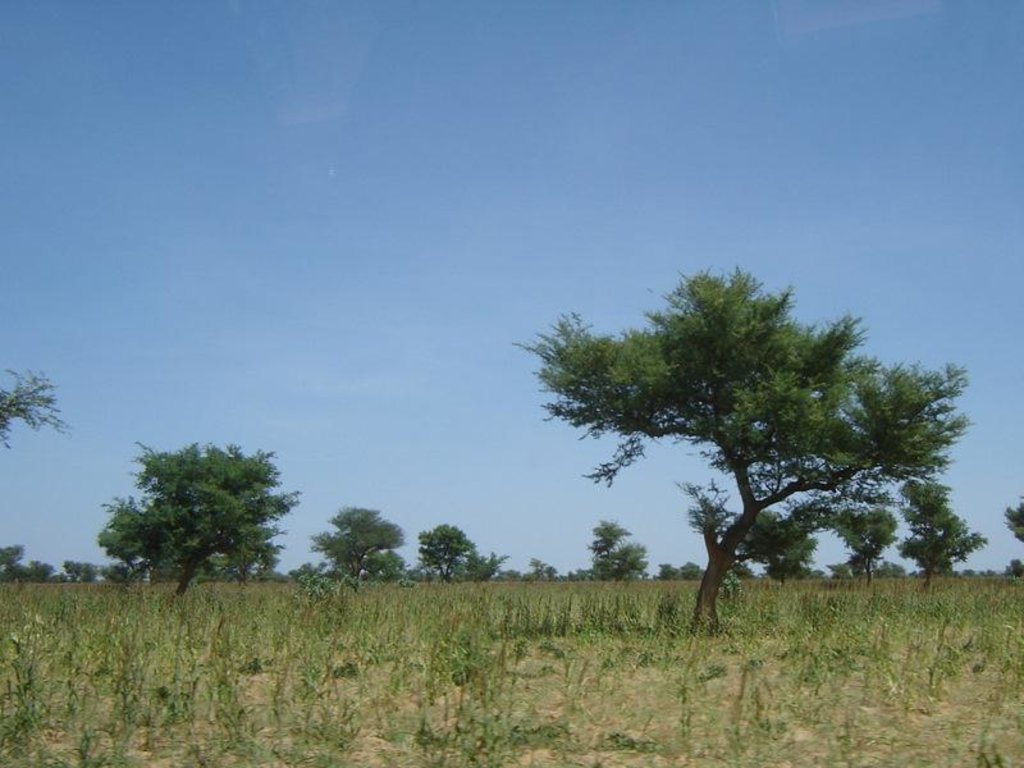Parkland Agroforestry System [Burkina Faso]
- Creation:
- Update:
- Compiler: Unknown User
- Editor: –
- Reviewer: Fabian Ottiger
technologies_1345 - Burkina Faso
View sections
Expand all Collapse all1. General information
1.2 Contact details of resource persons and institutions involved in the assessment and documentation of the Technology
Key resource person(s)
SLM specialist:
Bayala Jules
secoraf@coraf.org
Conseil ouest et centre africain pour la recherche et le développement agricoles (CORAF)
Burkina Faso
Name of project which facilitated the documentation/ evaluation of the Technology (if relevant)
Book project: SLM in Practice - Guidelines and Best Practices for Sub-Saharan Africa (SLM in Practice)Name of the institution(s) which facilitated the documentation/ evaluation of the Technology (if relevant)
West and Central African Council for Agricultural Research and Development (WECARD/CORAF) - Senegal1.3 Conditions regarding the use of data documented through WOCAT
The compiler and key resource person(s) accept the conditions regarding the use of data documented through WOCAT:
Yes
2. Description of the SLM Technology
2.1 Short description of the Technology
Definition of the Technology:
Parklands are the traditional agroforestry systems of semi-arid West Africa or Sahel where naturally growing, valuable trees are protected and nurtured on cropping and grazing lands
2.2 Detailed description of the Technology
Description:
For the rural people in the Sahel, parkland trees are multipurpose: they are a grocery shop, a pharmacy and a silo at the same time. People rely on many locally cherished species to provide food and nutritional security for both human and livestock populations and to protect and enrich soils. Important tree species are baobab (Adansonia digitata), tamarind (Tamarindus indica), Faidherbia albida, shea nut or karité (Vitellaria paradoxa, see photo 1 below) and néré (Parkia biglobosa). Crop production can be increased below and around the trees (especially under Faidherbida albida) due to the favourable micro-climate, accumulation of soil organic matter through litter fall, prunings and root decay in the predominantly sandy and poor soils.
Parkland management practices include: assisted tree regeneration (see Assisted Natural Regeneration, Burkina Faso; and FMNR, Niger); Tree planting (mostly in vicinity of family compounds); Improved fallows (under which economically useful and fertility-improving trees are planted before cropping is discontinued) and fire protection. Farmers commonly apply silvicultural techniques to increase production of parkland trees. These include seedling protection and fencing, watering, and the selection of vigorous shoots. Pruning is done to improve productivity of trees, reduce shade and enhance understorey crop performance and to produce fuelwood and fodder. It stimulates leaf regrowth, causes an additional foliation peak during the rainy season and depresses pod production. Coppicing and pollarding represent a way of limiting competition with intercrops and providing wood and other tree products in species with good vegetative growth.
2.3 Photos of the Technology
2.5 Country/ region/ locations where the Technology has been applied and which are covered by this assessment
Country:
Burkina Faso
Further specification of location:
Saponé
Map
×2.6 Date of implementation
If precise year is not known, indicate approximate date:
- more than 50 years ago (traditional)
2.7 Introduction of the Technology
Specify how the Technology was introduced:
- as part of a traditional system (> 50 years)
3. Classification of the SLM Technology
3.1 Main purpose(s) of the Technology
- improve production
- reduce, prevent, restore land degradation
- conserve ecosystem
- reduce risk of disasters
- create beneficial economic impact
- create beneficial social impact
3.2 Current land use type(s) where the Technology is applied

Mixed (crops/ grazing/ trees), incl. agroforestry
- Agroforestry
Main products/ services:
Pearl millet
Comments:
Major land use problems (compiler’s opinion): Desertification, decline of soil organic matter and fertility, soil loss through water erosion
3.3 Further information about land use
Water supply for the land on which the Technology is applied:
- rainfed
Number of growing seasons per year:
- 1
Specify:
Longest growing period in days: 120
3.4 SLM group to which the Technology belongs
- agroforestry
- rotational systems (crop rotation, fallows, shifting cultivation)
- integrated soil fertility management
3.6 SLM measures comprising the Technology

vegetative measures
- V1: Tree and shrub cover
Comments:
Main measures: vegetative measures
Type of vegetative measures: scattered / dispersed
3.7 Main types of land degradation addressed by the Technology

soil erosion by water
- Wt: loss of topsoil/ surface erosion

soil erosion by wind
- Et: loss of topsoil

chemical soil deterioration
- Cn: fertility decline and reduced organic matter content (not caused by erosion)

biological degradation
- Bc: reduction of vegetation cover
- Bq: quantity/ biomass decline
- Bs: quality and species composition/ diversity decline

water degradation
- Ha: aridification
Comments:
Main type of degradation addressed: Wt: loss of topsoil / surface erosion, Et: loss of topsoil, Cn: fertility decline and reduced organic matter content, Bc: reduction of vegetation cover, Bs: quality and species composition /diversity decline
Secondary types of degradation addressed: Bq: quantity / biomass decline, Ha: aridification
3.8 Prevention, reduction, or restoration of land degradation
Specify the goal of the Technology with regard to land degradation:
- reduce land degradation
4. Technical specifications, implementation activities, inputs, and costs
4.2 Technical specifications/ explanations of technical drawing
Technical knowledge required for field staff / advisors: moderate
Technical knowledge required for land users: low
Main technical functions: control of raindrop splash, increase in organic matter, increase in nutrient availability (supply, recycling,…), reduction in wind speed, promotion of vegetation species and varieties (quality, eg palatable fodder)
Secondary technical functions: stabilisation of soil (eg by tree roots against land slides), increase of infiltration, increase of biomass (quantity)
Scattered / dispersed
Vegetative material: T : trees / shrubs
Trees/ shrubs species: Faidherbia albida, Tamarindus indica, Vitellaria paradoxa, Parkia biglobosa, Adansonia digitata
4.4 Establishment activities
| Activity | Type of measure | Timing | |
|---|---|---|---|
| 1. | Retaining saplings from natural regeneration or wildings | Vegetative | before rainy seasons |
| 2. | Planting improved material (early stage) | Vegetative | |
| 3. | Grafting for shortening juvenile phase and improving fruit quality (initiation stage) | Vegetative | |
| 4. | Pruning to form erect canopy | Vegetative | |
| 5. | Protection from animals by dead or live fences | Vegetative |
4.6 Maintenance/ recurrent activities
| Activity | Type of measure | Timing/ frequency | |
|---|---|---|---|
| 1. | Weeding around seedlings when necessary | Vegetative | rainy season |
| 2. | Pruning as necessary (pruned branches are dried and used for fuelwood): annually | Vegetative | |
| 3. | Pollarding (pruning of side branches to improve light for understorey crops | Vegetative | |
| 4. | Felling some trees to reduce density as they grow bigger (during dry season) | Vegetative |
4.7 Costs and inputs needed for maintenance/ recurrent activities (per year)
Comments:
Machinery/ tools: All activities carried out by manual labour using machetes (panga) or hoes
Data on costs is not available. However, costs for management of the land use system are low; only some pruning and trimming of trees is needed which is effectively ‘harvesting’ of fodder and wood.
4.8 Most important factors affecting the costs
Describe the most determinate factors affecting the costs:
Data on costs is not available. However, costs for management of the land use system are low; only some pruning and trimming of trees is needed which is effectively ‘harvesting’ of fodder and wood.
5. Natural and human environment
5.1 Climate
Annual rainfall
- < 250 mm
- 251-500 mm
- 501-750 mm
- 751-1,000 mm
- 1,001-1,500 mm
- 1,501-2,000 mm
- 2,001-3,000 mm
- 3,001-4,000 mm
- > 4,000 mm
Specifications/ comments on rainfall:
Unimodal
Agro-climatic zone
- semi-arid
Thermal climate class: tropics
5.2 Topography
Slopes on average:
- flat (0-2%)
- gentle (3-5%)
- moderate (6-10%)
- rolling (11-15%)
- hilly (16-30%)
- steep (31-60%)
- very steep (>60%)
Landforms:
- plateau/plains
- ridges
- mountain slopes
- hill slopes
- footslopes
- valley floors
Altitudinal zone:
- 0-100 m a.s.l.
- 101-500 m a.s.l.
- 501-1,000 m a.s.l.
- 1,001-1,500 m a.s.l.
- 1,501-2,000 m a.s.l.
- 2,001-2,500 m a.s.l.
- 2,501-3,000 m a.s.l.
- 3,001-4,000 m a.s.l.
- > 4,000 m a.s.l.
Comments and further specifications on topography:
Altitudinal zone: 101-500 m a.s.l. (Saponé)
5.3 Soils
Soil depth on average:
- very shallow (0-20 cm)
- shallow (21-50 cm)
- moderately deep (51-80 cm)
- deep (81-120 cm)
- very deep (> 120 cm)
Soil texture (topsoil):
- coarse/ light (sandy)
- medium (loamy, silty)
Topsoil organic matter:
- low (<1%)
5.6 Characteristics of land users applying the Technology
Market orientation of production system:
- mixed (subsistence/ commercial
Individuals or groups:
- individual/ household
Level of mechanization:
- manual work
Indicate other relevant characteristics of the land users:
Difference in the involvement of women and men: poor and better-off farmers (basically everyone who has land)
Population density: 50-100 persons/km2
5.7 Average area of land owned or leased by land users applying the Technology
- < 0.5 ha
- 0.5-1 ha
- 1-2 ha
- 2-5 ha
- 5-15 ha
- 15-50 ha
- 50-100 ha
- 100-500 ha
- 500-1,000 ha
- 1,000-10,000 ha
- > 10,000 ha
5.8 Land ownership, land use rights, and water use rights
Land use rights:
- individual
Comments:
majority has ownership of the land, few borrow
6. Impacts and concluding statements
6.1 On-site impacts the Technology has shown
Socio-economic impacts
Production
crop production
Comments/ specify:
through mulching and nutrient pumping
fodder production
Comments/ specify:
leaves used as fodder during dry season
Income and costs
farm income
Other socio-economic impacts
Fruit production
Socio-cultural impacts
national institutions
Comments/ specify:
stakeholder interaction
Housing
Comments/ specify:
More timber available
Ecological impacts
Soil
soil moisture
Comments/ specify:
mulching improves infiltration
soil cover
Comments/ specify:
mulch and canopy cover
soil loss
nutrient cycling/ recharge
Comments/ specify:
leaf litter and nutrient recycling
Biodiversity: vegetation, animals
plant diversity
animal diversity
Comments/ specify:
bees, birds, etc
Climate and disaster risk reduction
wind velocity
Comments/ specify:
affecting crops / homesteads
micro-climate
6.2 Off-site impacts the Technology has shown
reliable and stable stream flows in dry season
downstream flooding
downstream siltation
Deforestation
Comments/ specify:
Alternative source of fuel and timber
Employment
Comments/ specify:
Tree management and harvesting
6.3 Exposure and sensitivity of the Technology to gradual climate change and climate-related extremes/ disasters (as perceived by land users)
Comments:
Increased tolerance through the use of indigenous species
6.4 Cost-benefit analysis
How do the benefits compare with the establishment costs (from land users’ perspective)?
Short-term returns:
slightly positive
Long-term returns:
very positive
How do the benefits compare with the maintenance/ recurrent costs (from land users' perspective)?
Short-term returns:
slightly positive
Long-term returns:
very positive
6.5 Adoption of the Technology
If available, quantify (no. of households and/ or area covered):
100% of the area covered
Of all those who have adopted the Technology, how many have did so spontaneously, i.e. without receiving any material incentives/ payments?
- 90-100%
Comments:
100% of land user families have adopted the Technology without any external material support
Comments on spontaneous adoption: 10s of millions of people live in the traditional parklands of Burkina Faso, Mali, Senegal and Niger. In Mali alone an estimated 3.6 million people practice parkland agroforestry with 40 trees per hectare.
6.7 Strengths/ advantages/ opportunities of the Technology
| Strengths/ advantages/ opportunities in the compiler’s or other key resource person’s view |
|---|
| Generation of several ecological benefits |
| Wood provision for rural as well as urban population |
| Increased food security thanks to fruit production |
6.8 Weaknesses/ disadvantages/ risks of the Technology and ways of overcoming them
| Weaknesses/ disadvantages/ risks in the land user’s view | How can they be overcome? |
|---|---|
| Seedlings and wildings not always readily available | encourage local seed collection and setting up of group tree nurseries |
| Livestock sometimes damage the young seedlings | protection by fencing |
| Dry periods result in low seedling survival rates: planting not possible in dry areas | combine technology with fencing |
| Competition with crops | regular pruning of side branches |
| Long period to fruiting | use vegetative propagation of superior trees |
7. References and links
7.2 References to available publications
Title, author, year, ISBN:
Jonsson K, CK. Ong and JCW. Odongo. 1999. Influence of scattered nere and karite trees on microclimate, soil fertility and millet yield.
Available from where? Costs?
Experimental Agriculture 35:39-53.
Title, author, year, ISBN:
Bayala J., J. Balesdent, C. Marol, F. Zapata, Z. Teklehaimanot, SJ. Quedrago. 2006. Relative contribution of trees and crops to soil carbon content in a parkland system in Burkina Faso using natural 13C abundance.
Available from where? Costs?
Nutrient Cycling in Agroecosystems 76:193-201.
7.3 Links to relevant information which is available online
Title/ description:
Boffa, J.M. 1999. Agroforestry parklands in Sub-Saharan Africa. FAO Conservation guide no.34, Rome, 230pp
URL:
http://www.fao.org/docrep/005/x3940e/X3940E00.htm#TOC
Links and modules
Expand all Collapse allLinks
No links
Modules
No modules





